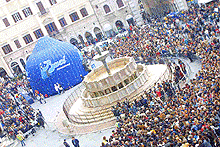Festival Finding in Italy Made Easy
 One of the best ways to get to know a country is to get to know its festivals. While this often means braving crowds (something savvy tourists try to avoid), it also can mean seeing a city or region at its best. Some festivals are also mainly local events, drawing few tourists, so even if you’re one of thousands of attendees you still might be one of only a few who aren’t from the immediate area.
One of the best ways to get to know a country is to get to know its festivals. While this often means braving crowds (something savvy tourists try to avoid), it also can mean seeing a city or region at its best. Some festivals are also mainly local events, drawing few tourists, so even if you’re one of thousands of attendees you still might be one of only a few who aren’t from the immediate area.
[Update: It appears that the guy behind the festival finder I glowingly reviewed here has begun a partnership with a different website, so the site has changed. I’m updating the links here, but the information may not all have moved yet.]
Italy gives the traveler countless opportunities to enjoy local festivals – it seems like some part of the country is in party mode at any given moment. There are the saint’s days, food-related celebrations, sporting events and more. Thankfully, there’s a great online Italian festival finder here – you can look them up based on the time of year or the region of the country, which is perfect for someone who’s visiting for a short and pre-determined amount of time.
Some highlights I found just by playing around…
- You might think a category of festivals called “Self-Beaters” wouldn’t yield many results, but you’d be wrong. There are, count ’em, six festivals that fall under this category. One of them is described thusly: “On Good Friday there is a solemn parade in homage to the Madonna that dates back to a horrific medieval period in which the men of the town parade about town hitting themselves with objects imbedded with glass and nettles while the townsfolk wail, sob and groan in sympathy. They make themselves bleed and many of them actually cause scarring injury to themselves. This pathetic ritual has remained almost intact since ancient times even through its existence is poorly justified. The self mutilation is followed by food (who could eat?) and merrymaking (including, probably, lots of drinking) all over town.”
- A request for the pick of the litter from my birthmonth (February) reveals another chocolate festival – I knew about the chocolate festival in Perugia that takes place every October, but I didn’t know about Eurochocolate Torino. It’s an “International Chocolate Exhibition that is twinned with the world famous October event of the same name that is put on in Perugia every year and attracts close to half a million revelers. Sweet-toothed visitors from the entire province of Piedmont descend on this medieval city to partake in many unique chocolaty activities, including rides on the ‘Chocoboat’ and the ‘Chocotram’ both of which serve tantalizing incarnations of the high-calorie indulgence during tours of the festival sites, which are easily found using the ‘Chocomap’.” I know where I want to spend my birthday next year.
- This month in the Lazio, in the city of Paliano to be precise, there’s something called a “Food Palio” – it’s a competition between the neighborhoods where each puts its best dishes to the test and are judged against one another. The snippet on the holiday finder doesn’t say if innocent bystanders get to try the goods, too, but there’s more information for this food fight. Sounds like the perfect way to spend a weekend.
- Lest you think the beverages of choice in Italy are only wine and coffee, there are beer festivals in the country as well. Not surprisingly, many of them are in the northern parts of the country – the ones closer to Austria and Germany, and the ones where German (or some variation of it) is still spoken. Some sound like mini-Oktoberfest celebrations, but this one caught my eye: “Heavy Drinkers World Championship – the world’s title always wastes the majority of its contestants before the winner remains standing. Since the judges usually participate with the contestants, many times the official announcement of the winner of the title must wait for the following morning.” Now that’s a party.
- Satisfy your inner pyromaniac with a visit to one of the bonfire festivals. One that takes place in January is “The fire of San Antonio – this typically celebrates the purging of the old year and the purification of the new year by fire. Giant bonfires are built depending on the creed of the towns. They are either fed purely Rosemary wood, or they are started inside a hollowed out giant trunk. Some towns feed their fires old, discarded wooden items that the townsfolk have saved throughout the year. Wood gathering begins several days before the bonfire and is considered a joyful activity with everyone joining in. During the bonfire itself, many people run into it’s margins and do three spins with the fire under their feet. They believe this purifies them of the sins of the year before and allows them to start the new year with a clean slate. Despite the variety of methods, the fires are huge and plentiful on this night and the celebrations continue into the wee hours until only the embers remain. The older celebrants gather up the embers of the bonfires lit on this night and put them on their own hearths as a good omen and to be blessed by the Saint.”
If you’re planning a trip to Italy, this Italian holiday finder is well worth using. And if you’re not already planning a trip, play with the searches for awhile and you’ll want to begin.